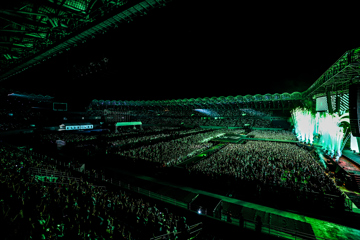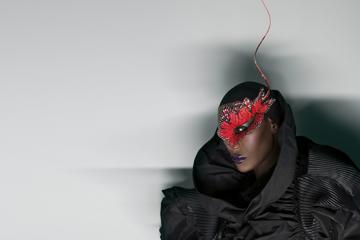Violent Femmes' Brian Ritchie On Placing Music In Unusual Spaces For Mona Foma 2023
We caught up with Brian Ritchie to discuss this year’s iteration of Mofo. As always, Mofo offers an eclectic mix of musical genres, diversity in race and gender, and an otherworldly live music experience that goes beyond our expectations of a festival.

Brian Ritchie is a musical hero. As the bassist in the Violent Femmes, he has played on ten albums, including the #26 ARIA 1991 record, Why Do Birds Sing? He has also released three solo albums: 1987’s The Blend, 1989’s Sonic Temple & Court Of Babylon, and I See A Noise, released in 1990. While he was born and raised in the United States, Ritchie has lived in Hobart since 2008 with his wife, and his mother-in-law is a permanent resident. On 26 January 2012, he and his wife became Australian citizens – Ritchie currently holds dual citizenship with the US and Australia.
In 2009, the shakuhachi (a Japanese bamboo flute) enthusiast curated the inaugural Mona Foma (better known as Mofo) festival. Richie has curated each edition of the festival ever since. In 2010, he joined The Break as a touring bassist, rounding out the supergroup that featured Midnight Oil’s Rob Hirst, Jim Moginie, and Martin Rotsey.
We caught up with Brian Ritchie to discuss this year’s iteration of Mofo, which features an artist he looks up to – UK performer Kae Tempest, as well as Bon Iver, Angel Olsen, American composer Nico Muhly, Bikini Kill, Pavement, Peaches, Soccer Mommy, and many more. As always, Mofo offers an eclectic mix of musical genres, diversity in race and gender, and an otherworldly live music experience that goes beyond our expectations of a festival.
A few years ago, in an interview with The Music, you reflected on ten years of Mona Foma and said that you still feel like you just started the festival yesterday. Do you still feel that way?
Well, it's interesting, because we just had a meeting, where we were talking about the future of the festival. We're constantly reinventing ourselves. So, there's a lot of freedom that we have to mix commercial ideas with really, totally uncommercial ideas and then put it all together in a different framework every year, which never gets boring.
Don't miss a beat with our FREE daily newsletter
Yeah, the festival is always changing, not just in the line-up but in locations.
We've been dealing with a lot of flux in the last three years in particular because of the, you know what, and now that we're coming out of it, it's got more of the trappings of the older festivals. In fact, maybe we have even more international representation than usual. But there's still a lot of room for creative ideas on the side and in the context of this fairly international program.
It's a very impressive, exciting, diverse line-up, as always. Who are you most excited to see?
Well, the thing I'm most excited about is not a who. It's a what. It’s the old TAFE building, which is now called the reunion district in Launceston. So we're taking over an entire Old TAFE, building and populating it with artworks throughout what used to be the classrooms, after party and what used to be the library and concerts in both the Quadrangle and also in a couple of other kind of found weird spaces.
Like, there's one called the punk bunker, which I'm really excited about. It's exactly what it sounds like. It's a concrete bunker that we're putting punk and metal bands into. And we're doing something similar in Hobart, called The Party, which is our after-show in Hobart, which will be taking place in what used to be the printing area for the Mercury newspaper when the newspaper was all in one site. Editorial was upstairs and then down in the bowels of the newspaper office, they print the newspapers and do all that production aspect of it, and that's what where the party is going to be. So, it's an industrial found space that's really unusual and full of little nooks, crannies, and weird experiences.
I love hearing that you've done so much with the old TAFE building. That sounds incredible.
Thank you! I think people who went to the TAFE should come because they're going to see it in a whole different light, but visitors should come because it's going to be an all-out art experience, crossing boundaries of theatre, music, video art, performance art, and installations.
We have something from Terrapin Puppet Theatre, which is called Anthem Anthem Revolution, where they you play a ping pong, on, I guess, the computer, and as you're doing that, it unlocks the melody and words of a new national anthem. It's kind of hard to explain, but it's highly original stuff. All of this is within a stone's throw of the TAFE building. I mean, you can just walk around; it's all in one place. We've been avoiding the festival hop concept for a few years because of COVID restrictions, but we're embracing it this time in this festival. It will be quite interesting.
It sounds expansive, and it sounds like there's something for everyone – such an interactive event.
There is one interactive work I can mention that will be at the old TAFE, which is [Australian noise music artist] Robin Fox has a laser and sound show that's for one person at a time, so you queue up and then once you get in there, you control the lasers in the sound in a dark room. It's totally psychedelic.
Awesome. Who are you most stoked about booking on the line-up?
Well, we've been trying for several years to get Nico Muhly, a fantastic contemporary composer from New York. And, like so many things, that had to be sidelined. So, we can finally present Nico, and he'll perform with the Tasmanian Symphony Orchestra.
And then also he's doing a concert with Nicholas Tallput up in Launceston, who is a Launcestonian countertenor. Nico happens to have quite a few pieces for countertenor and piano. So, he'll be performing that in the St. John's Church, which is a beautiful venue. Very traditional, of course. I'm really excited about Nico finally coming; this is the third year we've tried to bring him in. Third time's the charm.
I’m also really excited about Kae Tempest.
Oh, I love Kae Tempest.
I think they performed at Mofo maybe five or six years ago, maybe seven years ago, and that was a real eye-opener. Great performer; I consider like the Jimi Hendrix-like peak experience performer of this particular generation. So, I’m looking forward to seeing Kae again, and we'd like to do a collaboration.
We have a really interesting collab collaboration between Them Demons Band, who are an early music ensemble from Tasmania, playing instruments from the Renaissance period. They’re playing historical musical instruments, but they're collaborating with an ensemble couple from Afghanistan. This is going to be it sounds crazy, but it actually does work together musically. That's going to be fascinating, and they're performing in both Hobart and Launceston, so that's something that anybody can see, regardless of which part of the festival they attend.
Amazing. Will you be making any guest appearances this year?
We're having a show called Songs For freedom, which is presented by Big hArt. What they've done is they've done some writing workshops in prisons around mainland Western Australia, and they're doing a series of talks around the capital cities trying to raise the profile of unfair and excessive incarceration rates among Aboriginal people. So, they've taken some songs that they've worked on in the prison and turned it into a show, and I played on the recording. I think that I'll probably also be playing live.
What an important message to send.
Yeah, it is. I bet I've done at least a cameo at every Mofo. Sometimes, I've performed in Violent Femmes or The Break, but other times I just do a cameo, at least because there’s no point in me working on an entire festival and not playing at least a little bit. I don't have to pay myself either. So, it helps the budget [laughs].
I loved reading your thoughts on what makes a great music city. You mentioned chaos, noise, and beauty interrupting people's concentration, which is what music should do. Did you grow up in a musical city or spend much time in one before Violent Femmes?
Well, Milwaukee wasn’t a music city, but when I retrospectively look at it, it had a pretty healthy music scene. But I wouldn't characterise it as a true all-in Music City. Like for example, New Orleans is a music city. In New Orleans, you can walk down the street, and you see street performers playing jazz that goes back to the late 1800s because it's been handed down as a tradition.
I would like to see more cities dedicating themselves to this, and especially live music. I think Mona Foma has done a lot for Hobart and Launceston. It doesn't happen year-round, but we have placed music in a lot of unusual spaces. So, to me, a music city has music in places where it's not supposed to be. Not just in bars, not just in the concert hall, but on the street, in record stores and book shops, in the museum, and things like that.
I think Mofo has certainly done a lot for the music scene in Tasmania.
Well, I hope so, because that's very important to me. Music has been my whole life. And I want to not only think about the music that I'm doing, but also about the general music ecosystem and try to bring up some young performers or bring in people from the fringes. A lot of people don't really get equal access to platforms. So, with Mona Foma, we program over 50% female performers when most festivals would not have that kind of number. We don't do it as a quota; we just do it because it's good.
Just in our festival, we have Bikini Kill, who are pioneers of really opening up things for girls and women in rock music, and we have Angel Olsen on the bill. But here's the most inspiring and actually heroic female artists we probably have this year is Chloe Kim. She's doing 100 hours of live solo drumming, so that's 10 hours a day for the ten days of the festival.
Wow!
And she's doing it in different locations around the festival site and more than 10 locations. So, I think she's got to take the cake for her girl power this year [laughs].
Mona Foma 2023 begins on Friday, 17 February and concludes on Sunday, 26 April. Explore the full program and buy tickets here.







